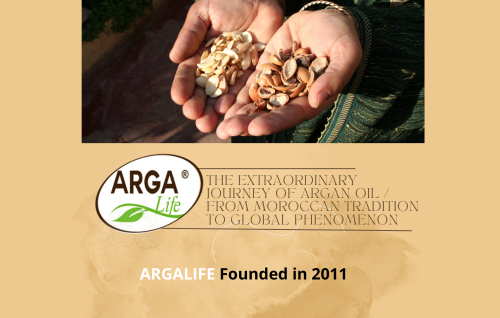Increase in value of goods
Once a closely guarded secret in Moroccan villages, Argan oil has now gone global, fetching prices of up to $300 per liter, making it the world’s most expensive oil. The past two decades have witnessed a dramatic change as the production of precious goods has transformed from a craft activity into a thriving multi-billion dollar industry.
Argan Tree: symbol of life
Argan tree, native to the desert region between the Atlantic Ocean and the Atlas Mountains in Morocco, has a sacred place in the lives of the Amazigh people. Centuries ago, these indigenous peoples harnessed the power of the argan fruit by using it in cooking and cosmetics. The tree itself is revered as the ‘tree of life’, providing food, shelter and desert protection, while its deep roots protect against erosion, allowing plants and grass to grow.
Craft traditions
Traditionally, Amazigh women are the keepers of argan oil, passing their knowledge and skills from generation to generation. This intricate and artisanal process begins by drying the argan fruit in the sun and then completely removing the pulp by hand. The remaining argan residues are then broken down to extract the oil-rich oil, a job that requires great skill and patience.
In the past, this activity focused mainly on the work of Amazigh women, who until 1956 asked their male counterparts for permission to leave their homes. The argan oil they produced was initially used mostly in cooking and was sometimes sold on the streets in refined bottles for up to $3 a liter.
Change
The revolution in the argan oil industry began in the late 1980s when researcher Zoubida Charrouf studied the argan tree for her Ph.D. Realizing the environmental and economic potential of this valuable resource, Charrouf decided to promote the benefits of argan oil for hair and skin in order to turn the environmental problem into an economic solution.
The growing popularity of argan oil has benefited not only the region but also the health of all species. Valuing the argan tree has ensured the sustainability of the species, benefiting both the environment and society.
Collaboration trips
The establishment of women-led cooperatives played an important role in the development of the argan oil industry. These cooperatives gave Amazigh women the opportunity to participate in the production and sale of these valuable products, giving them a degree of financial independence in a male-dominated society.
However, the advancement of Amazigh women remains a cause for concern as they often earn less than the national minimum wage, despite industry predictions that this figure will continue to rise. The challenge is to ensure that the economic benefits of argan oil are shared equally and that the traditional knowledge and skills of Amazigh women are recognized and valued.
Adultery and obstruction
As the demand for argan oil increased significantly, the impact of adulteration also increased. Cosmetic and cooking argan oils are often labeled as “pure” even though they contain an unknown percentage of cheap, synthetic oils. This threat to the integrity of the industry has prompted some cosmetic giants, such as L’Oréal, to implement fair trade programs, guarantee the supply of argan oil and protect the forest ecosystem.
Despite the problems, the argan oil industry continues to grow and the government aims to sell over 10,000 tons by 2025. However, this growth needs to be combined with the need to preserve the traditional customs and lifestyle of Amazigh women. The backbone of this change is unusual.
Results
The history of argan oil is a testament to the power of traditional knowledge, care for the environment and the resilience of people. From its humble beginnings in the villages of Morocco to its global status today, argan oil has captivated the world with its unique culture and unique production journey. As the industry continues to grow, it is imperative that the voice and welfare of Amazigh women, the custodians of this precious resource , remain at the forefront of the future.




